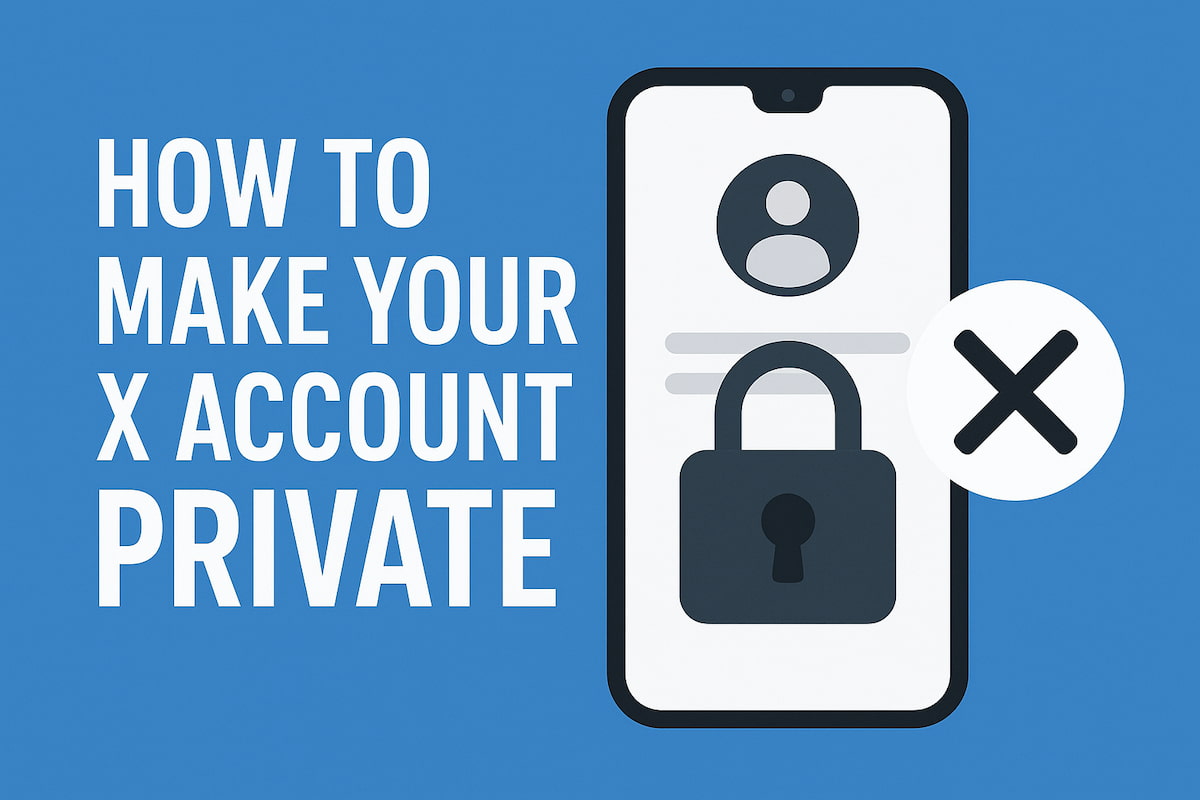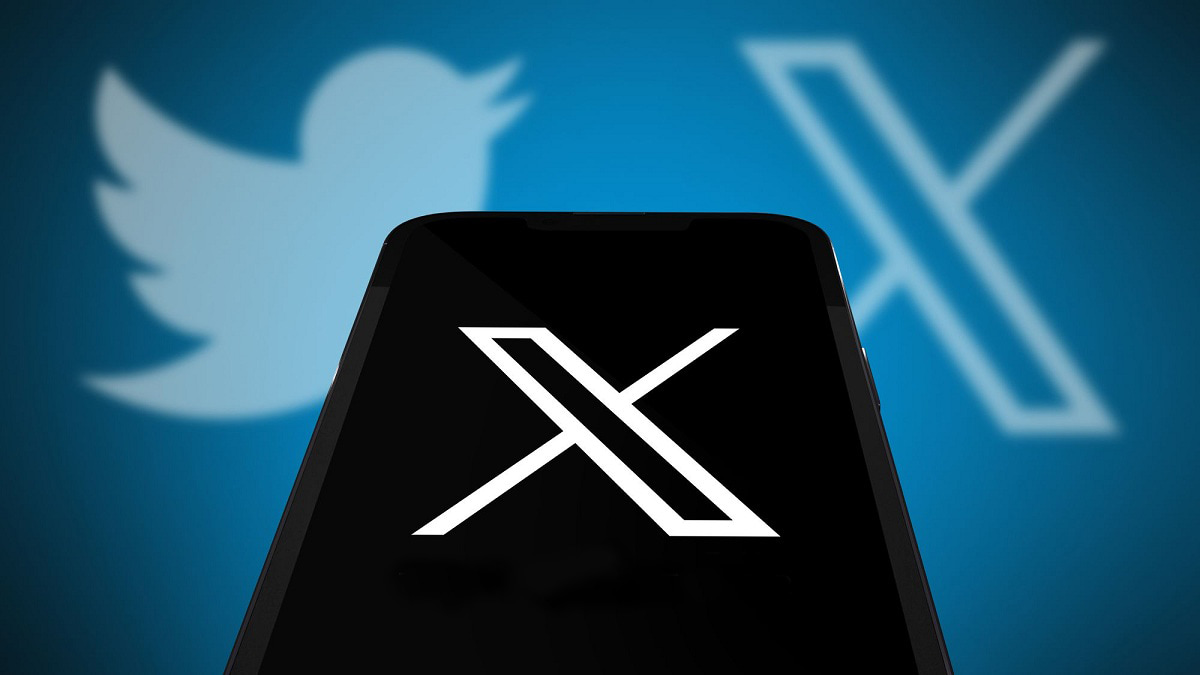Social media algorithms are crucial for expanding your online audience. Acting like a digital curator, they match users with content that fits their specific interests. By evaluating user activity, preferences, and interactions, these algorithms deliver tailored content designed to maintain user engagement.
As these systems evolve, marketers must stay agile and adapt to the latest trends to remain competitive. Understanding and adjusting to algorithm updates is essential for optimizing AI-driven marketing strategies and driving engagement.
This guide breaks down the basics of social media algorithm, covering the important factors to watch and how to fine-tune your marketing approach for improved outcomes.
What is a Social Media Algorithm?
Every time you scroll through a social media platform, the content you encounter is not random — it’s carefully selected based on your preferences and past interactions. This customized experience is made possible by social media algorithms, which are designed to personalize the content feed for each user.
At their core, social media algorithms are complex systems that use a variety of mathematical formulas to determine what content should appear in your feed and in what order. These systems analyze factors like
- Your browsing history;
- Engagement with posts;
- Interactions with specific users or topics.
By monitoring your behavior—such as what you like, share, comment on, or spend time viewing—algorithms predict which posts will be most relevant to you. This means that understanding how these algorithms work is essential not only for users looking to optimize their feed experience but also for businesses and content creators. These systems directly affect the visibility of posts and the frequency with which content from certain creators or brands appears in a user’s feed.
For marketers and content creators, knowing how social media algorithm function can be a game-changer. A deeper understanding of these algorithms allows you to craft content that aligns with what these systems prioritize, boosting your chances of gaining organic reach and engagement.
Why Were Social Media Algorithms Created?
Before the introduction of algorithms, social media platforms used a simple chronological timeline. The timing of your post was the most critical factor—if you posted when your audience was online, your content would appear in their feed. Users could scroll through their updates in reverse order and eventually see every post until they reached the “end” of their feed.
However, social media platforms eventually shifted away from this method, introducing algorithms to curate content based on relevance rather than timing. One key reason for this shift was to improve the user experience by prioritizing posts from friends and family while reducing the overwhelming amount of brand-generated content. This allowed platforms to show users content they were more likely to engage with, making feeds more personalized and interesting.
Another major factor behind the introduction of algorithms was to create a more profitable model for platforms. By deprioritizing organic content from businesses, platforms encourage brands to invest in paid ads for greater visibility. This move not only reduces the clutter of unsolicited posts but also provides social media companies with a revenue stream through advertising services.
The Importance of Social Media Algorithm
Social media algorithms are essential because they determine what content users see from the enormous amount available. For brands, this means algorithms directly impact the visibility of your posts—both for your existing followers and potential new ones.
These algorithms can have a significant effect. They are designed to show users content they are likely to engage with, based on their past interactions and ranking signals. If a user likes, comments on, or follows certain posts or accounts, the algorithm adjusts to display more similar content.
That’s why engaging with a few new accounts or liking posts from unfamiliar sources can quickly flood your feed with related content. For brands, the goal is to be included in that content stream, reaching users through the algorithm’s recommendations.
How Do Social Media Algorithms Decide What You See?
Social media algorithms vary by platform and are constantly evolving, but they generally function like a voting system.
As algorithms collect and analyze massive amounts of behavioral data, it becomes important for users to understand what information about them exists online. Using a digital footprint tool like the Aura digital footprint checker can help individuals see what personal data is publicly exposed and take steps to reduce oversharing risks.
For example, on Twitter (now X), factors such as the number of likes, favorites, and retweets a tweet receives contribute to its visibility. Each of these interactions adds “points” to the post.
Additional points are given based on the relationship between the user and the person who posted. If the user frequently interacts with that person or if they have a lot of followers, the post will earn more points.
As a result, each user’s feed is uniquely tailored, with the algorithm prioritizing content it believes the user is most interested in. This means no two feeds are exactly the same, as they are personalized based on individual interactions and preferences.
Why Do Social Media Algorithms Change?
Social media algorithms are updated frequently to improve user engagement and maintain the platforms’ effectiveness.
- Improve User Experience: The main reason for algorithm updates is to enhance the user experience. Platforms adjust their algorithms to show more relevant content based on your previous interactions, keeping users engaged for longer periods;
- Combat Bots and Spam: Algorithms are also modified to combat bots and spam. These updates help detect and filter out fake activity, ensuring users have a more authentic experience without disruptive or harmful content;
- Increase Content Reach: Algorithm changes also impact how content is distributed. Platforms adjust their systems to balance user experience with promoting engaging content. This can shift the order in which posts are displayed, prioritizing content that generates higher user interaction.
How do Social Media Algorithm Operate?
Social media algorithm determine what content appears in your feed, tailored based on your interactions with the platform. For instance, TikTok’s “For You Page” curates content specifically for you, using data from your past behavior. Similarly, X offers a “For You” and “Following” timeline.
These content recommendations are made by algorithms, not by humans manually selecting posts. Every social media platform uses different algorithms, but they all rely on machine learning and ranking signals. These signals help determine which pieces of content are most relevant to each user at any given moment.
Scale AI alternatives can support this process by helping train and refine the underlying algorithms, making recommendations more accurate and personalized.
In simple terms, algorithms scan the available content, assign a score, and rank it based on how well it matches your behavior and preferences. For example, Facebook’s algorithm uses ranking signals that adapt to your previous interactions, ensuring that you see content that keeps you engaged.
How Social Media Algorithms Shape Your Content Feed?
Social media platforms use algorithms to tailor the content you see based on your activity and preferences. Here are a few examples of how these algorithms work:
- YouTube: The platform suggests related videos based on your search history and previous views. Videos that are frequently watched together appear as recommendations next to your current video. Eye-catching YouTube thumbnails can make a big difference in whether your video gets clicked among these suggestions. Creating custom thumbnails helps your content stand out and attracts more viewers;
- Instagram: The platform offers interactive features like an “Interested or Not Interested” poll beneath suggested Reels to better understand your preferences. Instagram’s “Explore” page also curates videos and posts aligned with your viewing habits. If you regularly watch cat videos, your Explore page will be filled with similar content;
- LinkedIn: Posts labeled “Suggested” are displayed in your feed if they’re relevant, high-quality, and aligned with your professional interests. These posts are recommended based on your interactions and connections;
- X: The platform suggests accounts to follow based on your search history and interactions, helping you discover new profiles that match your interests.
This curated content helps platforms keep users engaged by constantly offering relevant and appealing suggestions based on individual behaviors.
What are the Key Social Media Algorithms?
Each social media platform uses its own algorithm to manage how content is curated and displayed to users. These algorithms rely on specific ranking signals to understand user preferences. Below, we’ll explore the main social media platforms and the unique ranking signals they use to prioritize content.
Twitter’s Algorithm
Twitter’s algorithm is powered by AI and curates content based on your interests, preferences, and past interactions rather than simply showing Tweets in chronological order.
Its system processes around 500 million Tweets daily to ensure that only the most relevant ones appear on your timeline, much like AI development services tailor advanced solutions to meet specific user needs.
For those looking to track who follows who on Twitter, AI tools can provide valuable insights into follower patterns and interactions, helping brands optimize their strategies.

Twitter’s algorithm takes the following factors into account:
- Location and Language: Content is tailored based on your location, especially in the “Trends for You” section;
- User Interactions: Recommendations are based on your activity, such as who you follow and engage with;
- Engagement: Tweets with more likes, Retweets, and replies are prioritized;
- Relevancy: Tweets are ranked based on the relevance of keywords, your interests, and previous interactions;
- Recency: Newer Tweets are given priority, particularly in trending and real-time sections;
- Profile Reputation: Active profiles that engage with others have higher visibility. X uses TweetCred to assess account credibility;
- Similar Accounts: Profiles are grouped based on the topics or niches they discuss.
Facebook’s Algorithm
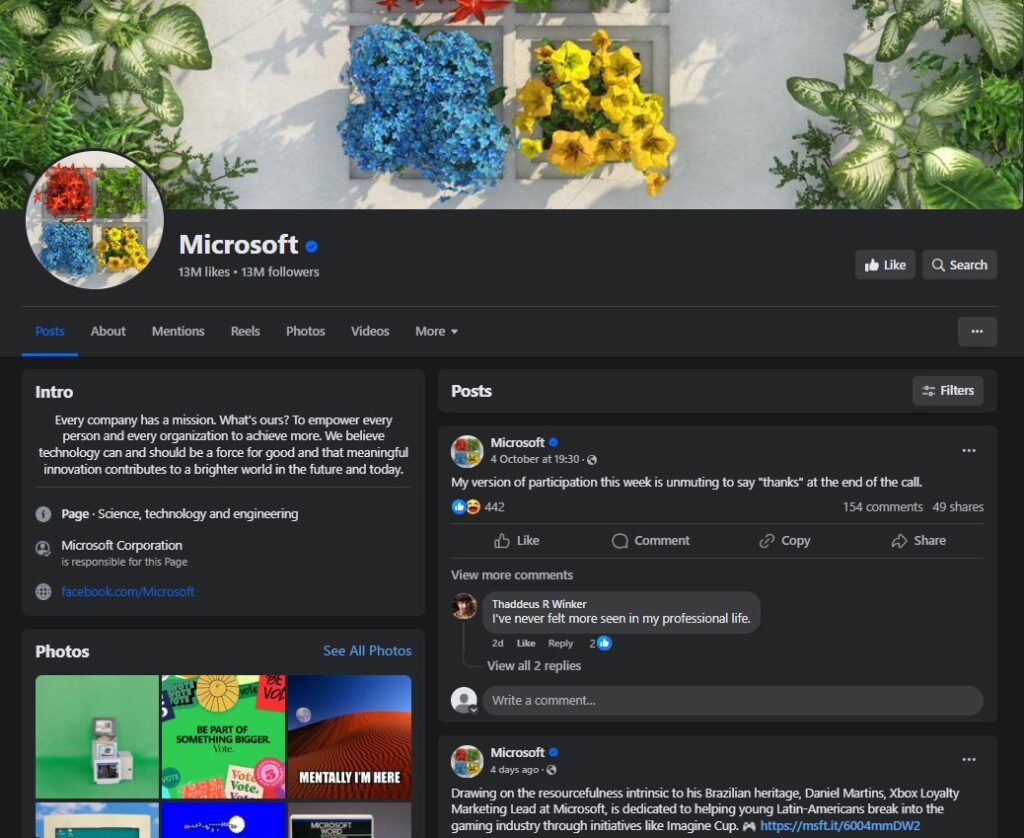
With over 2 billion active users, Facebook’s algorithm is designed to display content that users are most likely to find interesting. It uses a combination of several signals to decide what appears in each user’s feed.
Key factors considered by Facebook’s algorithm include:
- Timing: Recent posts are given priority in user feeds;
- Demographics: Your location, language, and gender help predict your content preferences;
- Account Credibility: Pages and profiles with strong credibility and engagement receive higher rankings;
- Content Type: Facebook prioritizes the type of content you interact with, showing more of what you typically engage with (e.g., videos, images);
- Relevance: Posts containing similar keywords or hashtags that align with your interests are favored;
- Engagement: High levels of engagement (comments, shares, likes) signal quality content, which Facebook ranks higher;
- Connections: Content from accounts you follow is prioritized over non-followed accounts.
All of these factors combine to give each post a relevance score, determining its likelihood of appearing in your feed.
Instagram Algorithm
Instagram’s algorithm tailors content across different sections of the platform, including Feed, Stories, Explore, Reels, and Search. Each section uses different ranking signals to recommend content based on user behavior.
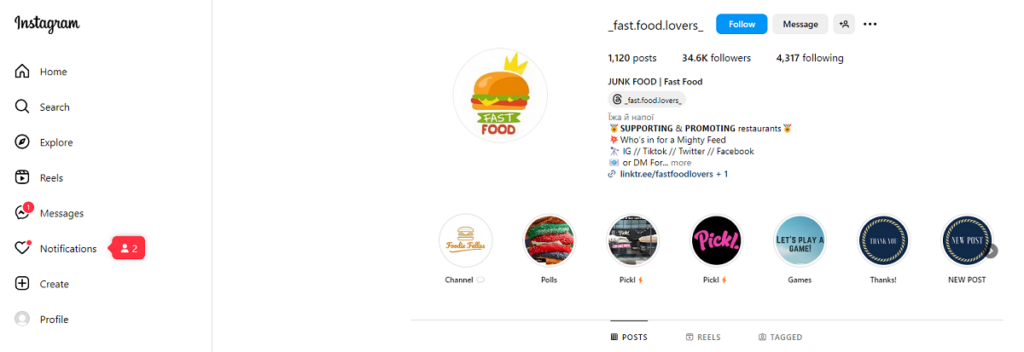
Instagram Feed
Your feed shows a mix of posts from people you follow, similar accounts, and ads. Posts are ranked based on these key factors:
- Post recency: Newer posts are prioritized over older ones;
- Following: Content from accounts you follow appears naturally on your feed;
- User activity: Posts you’ve liked, shared, or commented on influence future recommendations;
- Content type: If you engage more with photos or videos, the feed will show more of that content;
- Post engagement: Posts with high likes, comments, and shares are more likely to be shown;
- Interaction history: The frequency of interactions with specific accounts boosts their content in your feed.
Instagram Stories
Stories are temporary posts that disappear after 24 hours. Their ranking factors are similar to the feed:
- Viewing history: Accounts whose stories you view frequently will appear first;
- Engagement history: Likes and responses to stories impact their ranking;
- Closeness: Stories from users with whom you have mutual connections or DM interactions will rank higher.
Instagram Explore
Explore helps you discover new content from accounts you don’t follow. Recommendations are based on:
- Past interaction: Prior engagements with similar content influence what appears in Explore;
- Post popularity: Posts with more likes, comments, and shares get higher visibility;
- User activity: Explore content is tailored based on what you’ve liked or engaged with in the past;
- Account interaction: Frequent engagement with specific accounts boosts their content’s appearance.
Instagram Reels
Reels are short videos from accounts you may not follow. The algorithm uses the following signals to recommend Reels:
- User activity: Your recent interactions with Reels content, such as likes, comments, and shares;
- Interaction history: Your previous interactions with an account influence whether their Reels appear;
- Relevance: Content is ranked based on popularity signals like likes and saves;
- Account popularity: The algorithm factors in an account’s overall engagement and follower count when recommending Reels.
Threads Algorithm
Although Threads is still a new platform, with 130 million monthly active users as of Q4 2025, it’s already gaining traction. For brands looking to establish a presence early on, here are the key ranking signals to know:
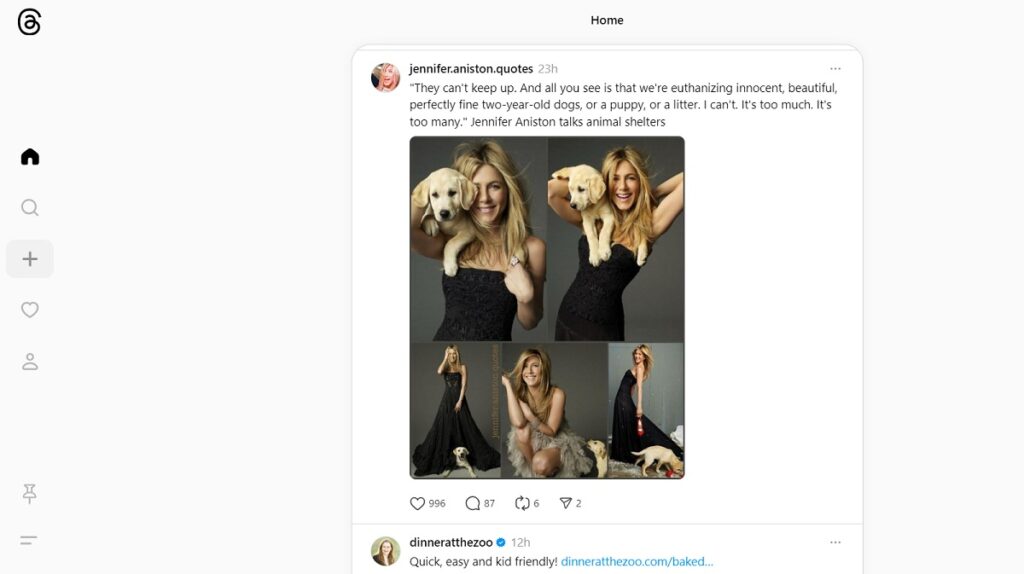
- User interactions: The algorithm considers how often you like a user’s posts, both in total and as a percentage of the posts you’ve seen. It also takes into account how frequently you’ve viewed that user’s Instagram profile;
- Popularity: Posts that receive more views, replies, and profile clicks from other users are ranked higher, boosting the visibility of both the post and its author.
TikTok Algorithm
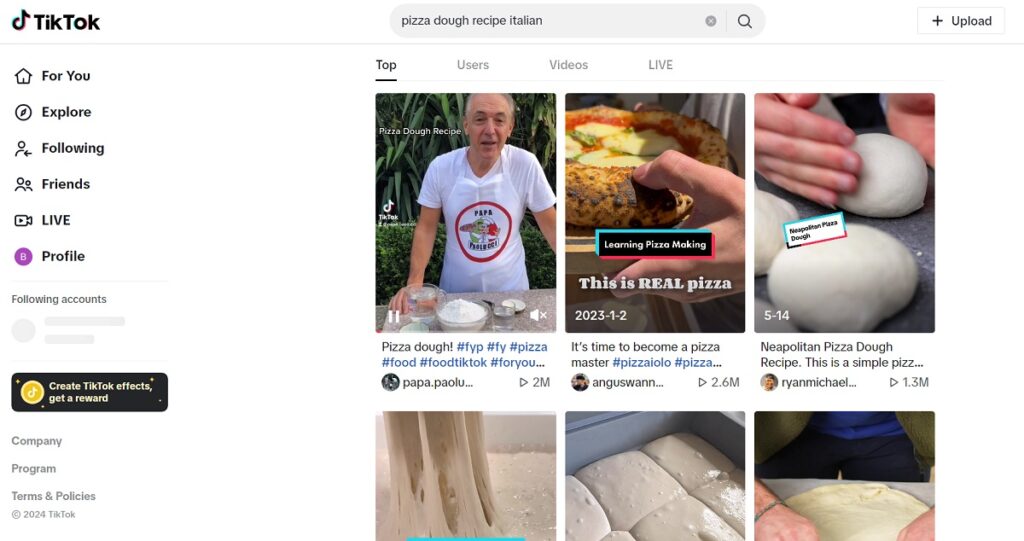
TikTok’s algorithm is a recommendation system designed to curate the For You Page for each user, taking into account the following factors:
- User interactions: Your likes, views, shares, comments, searches, and interactions with accounts help shape what content appears in your feed;
- Accounts you follow: Content from accounts you follow or similar suggestions is shown;
- Location: Trending and popular content from your region influences your feed;
- Video details: TikTok considers video quality, captions, sounds, and hashtags when recommending content;
- Device and account settings: Language, device type, and country settings impact the recommendations;
- Watch time: The number of replays and completed views of videos affects what appears in your feed.
YouTube Algorithm

YouTube’s algorithm ranks videos on its homepage using several signals, including:
- Video performance: Engagement metrics like likes, shares, and comments help determine video ranking;
- Click-through rate (CTR): The likelihood of users interacting with a video is a factor in YouTube’s recommendations;
- Watch time and retention: Videos with longer watch times and higher viewer retention are prioritized;
- Recency: Newer videos are more likely to be shown, especially to subscribers;
- User watch history: Past video views and interactions, such as likes or comments, influence recommendations;
- Search history: The algorithm considers past searches and recurring search terms to recommend relevant videos;
- Demographics and location: Content from creators in a specific location is initially shown to local viewers before being promoted more broadly.
LinkedIn Algorithm
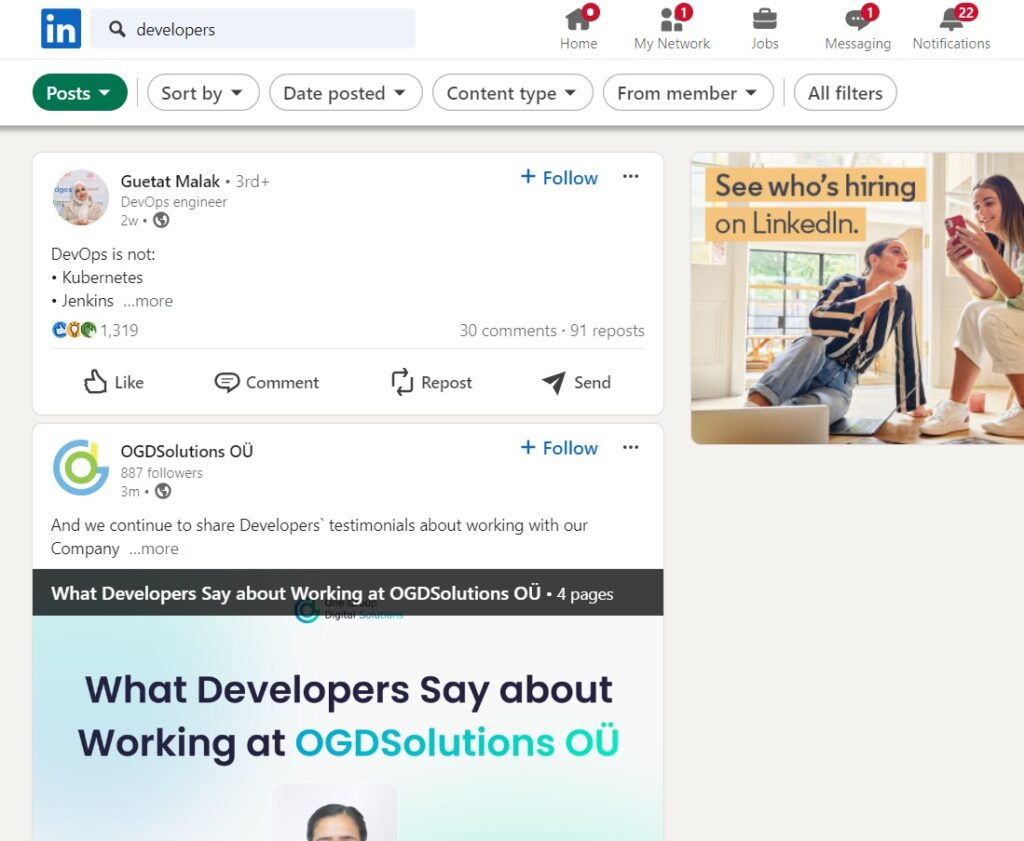
LinkedIn’s algorithm uses various ranking factors to determine the visibility and success of posts on the platform. Key elements include:
- Post quality: LinkedIn filters posts into three categories—spam, low-quality, and high-quality;
- Relevance: Posts are evaluated based on keywords, hashtags, and user comments;
- Engagement potential: Machine learning models predict how likely a post will receive engagement, especially within the first hour of posting;
- Personal connections: Posts from 1st-degree connections or users you frequently engage with are prioritized;
- Consistency: Regular posting increases visibility, as LinkedIn rewards active accounts;
- Credibility: Posts with insightful content, meaningful comments, and author expertise rank higher;
- Recency: New posts are given priority in user feeds;
- Content type: Short-form videos and well-structured long-form content tend to perform best.
Pinterest Algorithm
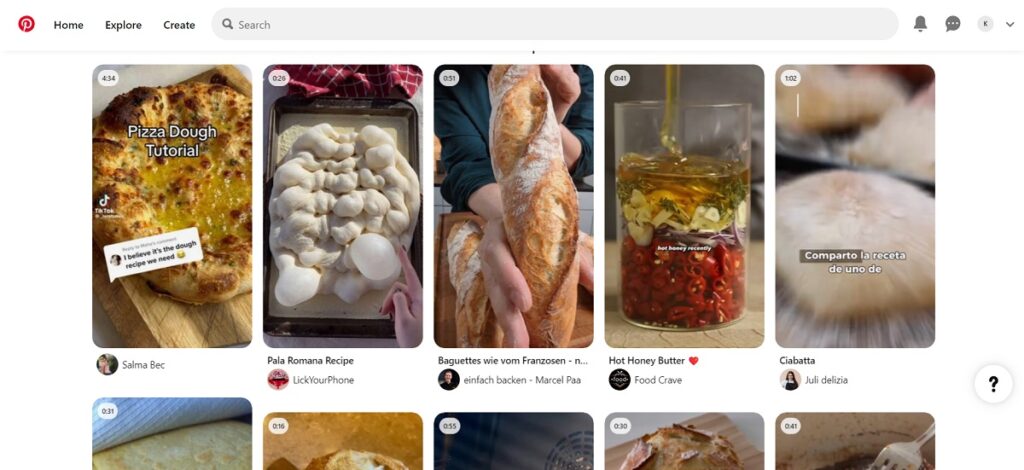
Pinterest’s algorithm ranks pins based on several signals:
- Topic relevance: Keywords, hashtags, and user interactions help Pinterest determine whether a pin is relevant to specific users;
- Pin quality: High engagement through likes, saves, and comments increases the visibility of a pin;
- Domain quality: Website credibility, user safety, and visitor engagement impact the ranking of content linked from your site;
- Account quality: Consistent posting and account credibility are important factors for successful Pinterest marketing;
- Recency: Newer pins or updated pins are given more visibility.
Reddit Algorithm
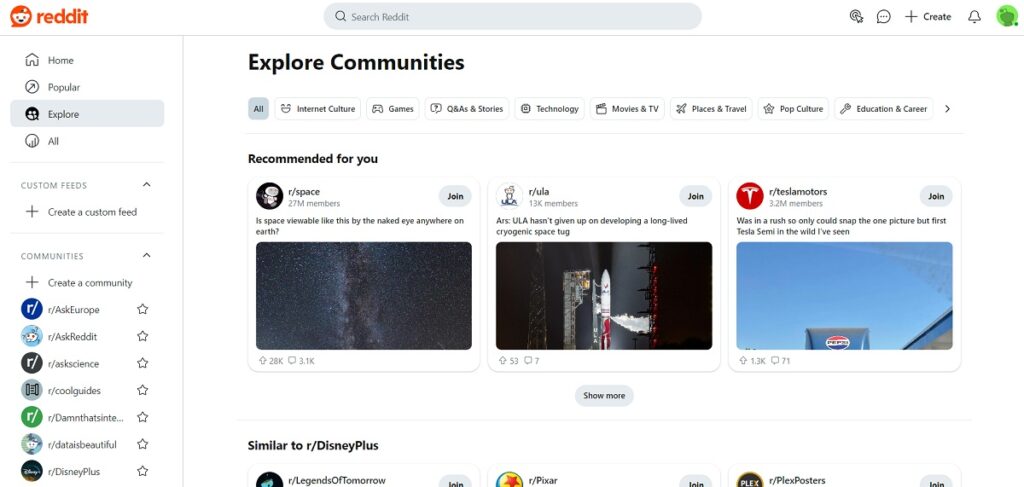
Reddit’s algorithm ranks content based on its popularity and relevance using these key factors:
- Upvotes and downvotes: Posts with more upvotes gain higher visibility, while downvotes reduce ranking;
- Recency: Newer posts have higher visibility, so regular posting is essential for keeping content relevant;
- Comment quality: The algorithm evaluates comments based on upvotes, with higher-ranked comments contributing to the visibility of the post.
Tumblr Algorithm
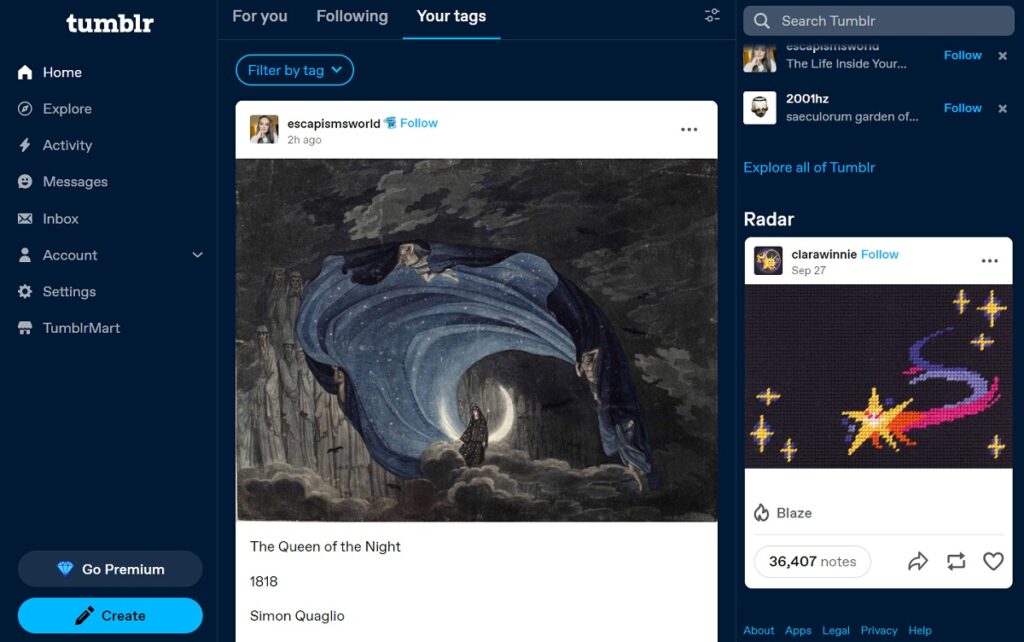
For those using Tumblr, here are the factors that influence post rankings:
- User interaction: Likes, reblogs, comments, and follows help increase content reach;
- Post content: The algorithm analyzes tags, text, images, and multimedia to recommend relevant posts;
- Post timing: Newer posts are prioritized for greater visibility;
- User preference: Content recommendations are based on past interactions, engagement, and followed blogs.
Strategies to Boost Your Reach on Social Media Algorithms
Social media algorithms are designed to connect users with content that matches their interests. By applying the right video marketing techniques, you can cut through the clutter and reach your target audience effectively.
Use Specific Captions, Keywords, and Hashtags
If your content is about vegan recipes but lacks relevant captions or hashtags, the algorithm may struggle to show it to the right viewers. Always include detailed information in your captions, along with relevant keywords and hashtags. Do some research to find trending topics and hashtags that can enhance your post’s visibility.
Use Humor and Emotions
Emotions are a key driver of engagement, especially humor. Videos that evoke laughter or joy often get shared more widely, which increases their performance in the algorithm. The more engagement your content receives, the more likely it is to be recommended to a broader audience.
Post at the Right Time
Timing matters when it comes to social media algorithm. Platforms like Instagram assess early engagement as a predictor of future success. To maximize your reach, use insights or third-party tools to identify when your audience is most active and post during those peak times.
Fine-Tune Your Content
It can be difficult to know what content will resonate most with your audience, so experimentation is key. Test different formats—whether it’s animated videos or live-action—and pay attention to what generates the most engagement. This will help you understand what your audience prefers and allow you to optimize your content accordingly.
Along with choosing the right format, focusing on a strong visual presentation is equally important. Effective social media graphic design can enhance your message, attract attention, and make your content stand out across platforms.
Keep It Short and Focused
Social media algorithm prioritize videos that hold viewers’ attention until the end. While videos don’t need to be extremely short, make sure you’re using only the necessary time to tell your story. Staying concise will help maintain engagement.
Stay Updated on Trends
Participating in trends and memes can boost your content’s visibility. Popular trends often come with built-in engagement, but make sure they align with your brand’s identity. Jumping on a trend that doesn’t fit your message can hurt your credibility and confuse your audience.
To avoid missteps, branding specialists can guide your team in selecting and shaping trend-based content that reinforces your core brand values while staying relevant.
Upload Videos Directly to Platforms
Each platform has specific video requirements, like file size and length limits. When you upload content, make sure it’s tailored to the platform you’re using. Natively uploaded videos typically perform better, as they meet the platform’s technical specifications and user preferences.
Grabbing a solid video editor online can be a total game-changer when you’re trying to nail those platform-specific requirements without breaking the bank on fancy software.
The cool thing about these online editors is how they let you quickly resize, trim, and adjust your content for different platforms without getting lost in complicated tech stuff.
What’s really sweet is that most of them come with pre-set export options for popular social platforms, so you don’t have to stress about whether your TikTok video will look weird on LinkedIn or if your Instagram Reel dimensions are going to get mangled in the process.
For TikTok creators looking to streamline their content production even further, an AI TikTok video generator can revolutionize the entire creation process by automatically producing platform-optimized content that meets TikTok’s specific 9:16 aspect ratio and duration requirements.
These intelligent tools not only handle the technical formatting but also analyze trending content patterns to suggest engaging visual elements, transitions, and effects that are currently performing well on the platform.
An AI TikTok video generator typically includes built-in templates designed specifically for TikTok’s algorithm preferences, ensuring that your content is optimized for maximum reach and engagement from the moment it’s created.
Encourage Audience Interaction
Engagement is a key factor in every social media platform’s algorithm. The more interaction your content generates, the more likely it is to be promoted. Create opportunities for your audience to engage with you—use polls, ask questions in your captions, or encourage them to share their thoughts to spark a conversation.
Define Clear Goals
Before creating content, establish the purpose behind your video marketing. Set clear campaign goals during the planning stage, and keep them in mind throughout the process. Having well-defined objectives helps you measure success and refine your strategy for future campaigns.
Be Genuine in Your Online Presence
Authenticity is vital for building trust and engagement on social media. Users, especially younger audiences, can easily detect insincerity.
For example, when you use AI tools to generate captions with minimal editing, users can easily sense the lack of human authenticity or identify it through an authentic AI detector. The erosion of authenticity through over-reliance on AI-generated content creates a paradox where brands save time on content creation but sacrifice the genuine voice and personality that actually drives audience connection and loyalty in the first place.
Stay true to your brand’s personality and values in all your content. Promote your products honestly and only follow trends if they align with your brand’s voice. Just because something works for others doesn’t mean it will fit your brand. Additionally, with how fast trends come and go, it’s important to be selective to maintain consistency and integrity in your digital presence.
The Role of AI in Social Media Algorithms
AI is essential to the functioning of social media platforms, driving the development and operation of algorithms that learn from user behavior and make decisions based on the data they collect. Here’s how AI plays a key role in social media algorithm:
1. Identifying Misinformation and Fake News
AI helps platforms detect and flag fake news and harmful content. For example, X uses machine learning, AI algorithms, user reports, and human moderation to spot misinformation, so AI detectors can be useful for verifying content before it spreads.
The algorithm evaluates tweet content and account history to verify accuracy.
Tools like Twilert offer an all-inclusive Twitter search solution that monitors conversations in real time, allowing businesses to track mentions, keywords, and trends to boost engagement and improve brand management.
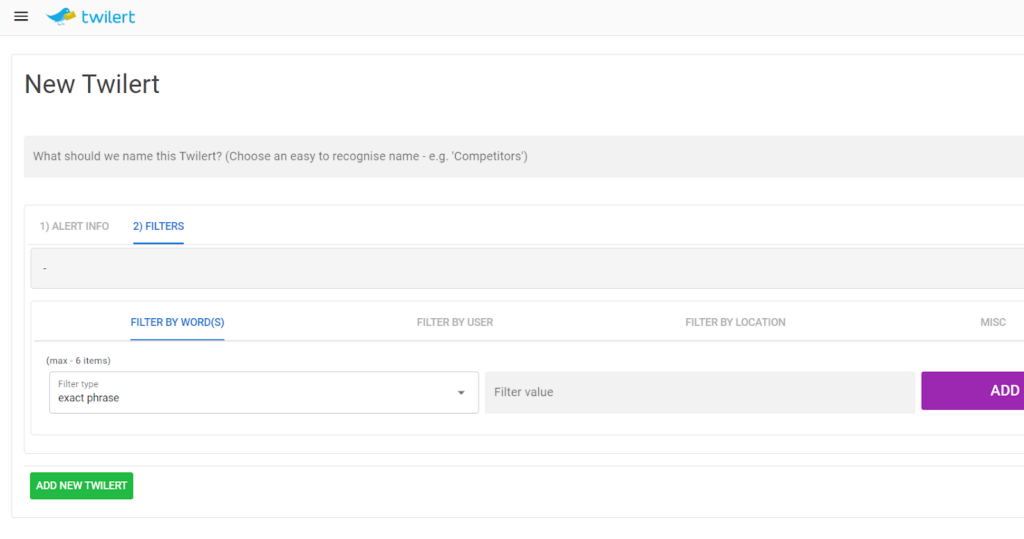
Twilert stands out with its advanced search tools, including Boolean operators, geo-targeting, and scheduled alerts, making it easy to capture relevant tweets even in fast-paced environments. Whether you’re tracking brand mentions, monitoring competitors, or uncovering PR opportunities, Twilert provides valuable insights by sending alerts straight to your inbox, ensuring you never miss a critical conversation.
2. Ensuring User Safety
AI plays a critical role in moderating harmful content. Social media platforms use AI to identify offensive or harassing behavior. For instance, Reddit employs machine learning to flag suspicious comments, while Facebook uses AI to detect abuse, fraud, and harmful content in posts, images, and videos, with human moderators reviewing flagged content.
Adding extra protection with tools like NordLayer (security network platform) can help safeguard accounts and data against unauthorized access while building audience trust.
3. Personalizing Content Delivery
AI-powered algorithms tailor content recommendations based on user behavior, such as follows, likes, and watch time. They segment users and provide personalized content by analyzing both explicit interactions and implicit signals. Users can further refine their experience by selecting keywords or hiding specific content.
Also, AI translation software can enhance personalization by localizing videos, captions, and descriptions to match each user’s language preferences.
4. Delivering Real-Time Analytics
AI enables social media platforms to process and analyze vast amounts of data in real time. Platforms like Facebook use AI to monitor user behavior, predict trends, and address security concerns immediately. This real-time analysis helps deliver personalized recommendations and improve the user experience.
Final Thoughts
Understanding social media algorithm is key to building an online presence or growing a brand. These algorithms decide what content users see and how often they engage with it. Platforms like Facebook, Instagram, TikTok, and LinkedIn use machine learning and user behavior to personalize content.
Marketers and creators must stay updated on how algorithms work to improve reach and engagement. This includes using relevant keywords, interacting with your audience, and adjusting to trends and updates.
Using AI tools and data insights can help you align your strategy with algorithms, ensuring your content reaches the right audience effectively.


